Architectus has revealed a bold concept vision for the Roma Street Precinct, stitching together layers of culture, history, and development to create a more connected, sustainable, and magnetic place for the future.
The idea is the outcome of Architectus’ latest ‘Charrette’, an annual event bringing together Architectus designers from different geographies, disciplines, and experience levels to respond to a unique design challenge.
“In 2022, our task was to imagine a new future for this important Brisbane precinct, where growth – new roads and rail in particular – has constrained the area’s rich history and future potential.” – Architectus
The concept is illustrated in a fly-through video (below) showing new bridges and boulevards for walkers and cyclists, green spaces for gathering and truth-telling, viewing platforms over the river, and revitalised heritage buildings.

The architectural firm has also imagined a new ‘Grand Central’ for Brisbane, with a canopy stretching from train station to parklands.
This is the 14th year of the firm’s Brisbane Charrette design event. According to Architectus, the collective effort reflects the ethos of the practice – giving designers a chance to share and explore powerful new ideas for Australia’s future cities.
Design Charrette 14 Roma Street Precinct from Architectus on Vimeo.
At each gathering the Architectus design teams are joined by industry leaders, who share their knowledge and brief them on the task.
For the Brisbane Charrette those collaborators included urban design and architecture academics, sustainability experts and First Nations contributors.
“Together, we explored the challenges and characteristics of the precinct, which stretches from the riverfront to the far side of Roma Street Parkland, with Turbot Street and Petrie Terrace marking its boundaries on either side. Part of the city’s ‘knowledge corridor’ for entrepreneurs and researchers, the precinct is already the focus of major renewal efforts.” – Architectus CEO Ray Brown.
Architectus CEO, Ray Brown said: “Our design team’s bold vision for the Roma Street Precinct benefits Brisbane’s status as a growing global city and future Olympic host. The concept creates a multi-connected, inclusive place where people can come together to enjoy many of the city’s greatest features.
“I’m proud of the creative, thoughtful solutions our designers develop in our Charrettes. It’s a testament to the collective power of different perspectives, backgrounds, and experiences, even in the face of a complex challenge.”
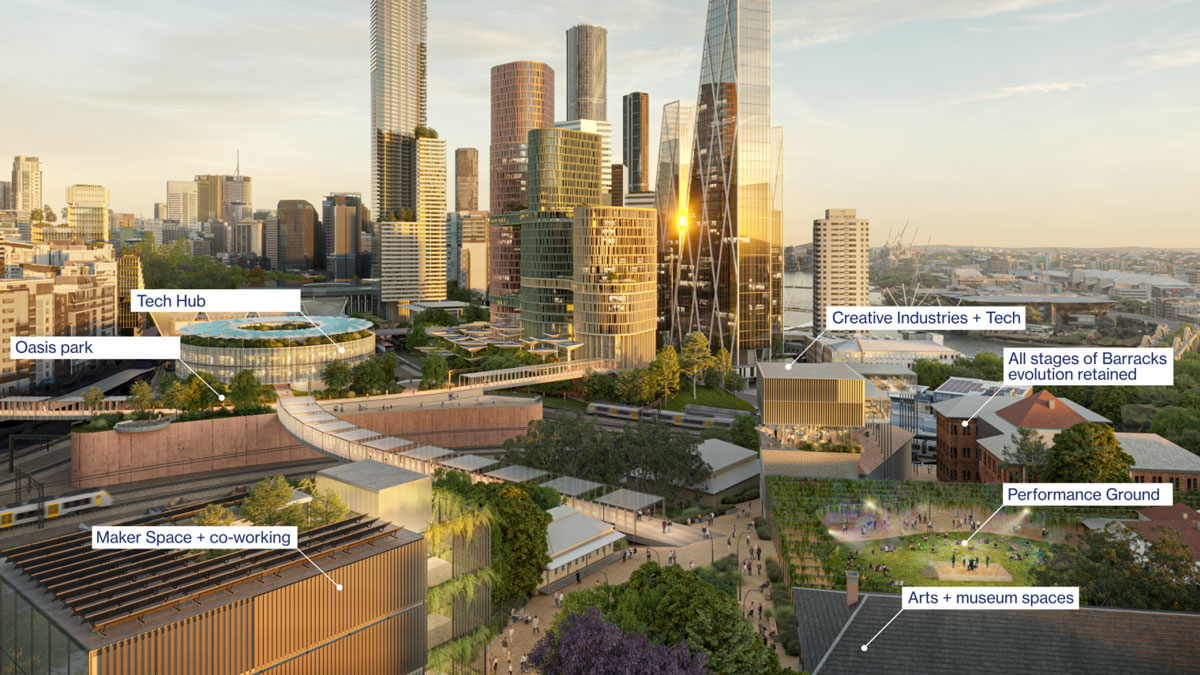
THE DESIGN CONCEPT
The overarching vision for Roma Street
The vision for the precinct involved weaving together the layers of this shared space – a site of ceremony, a meeting ground, a water story, a community – to focus on local economic development, social resilience, and connectivity.
The Roma Street precinct – known as Wilwinpa – was once a gathering place for tournaments and ceremony. The colonial city cut First Nations groups off from the tournament ground via the system of boundary streets, which were then buried under a tangle of roads and rail that disconnected the city from its vibrant inner suburbs. New pedestrian bridges and walkable boulevards stitch this community back together.
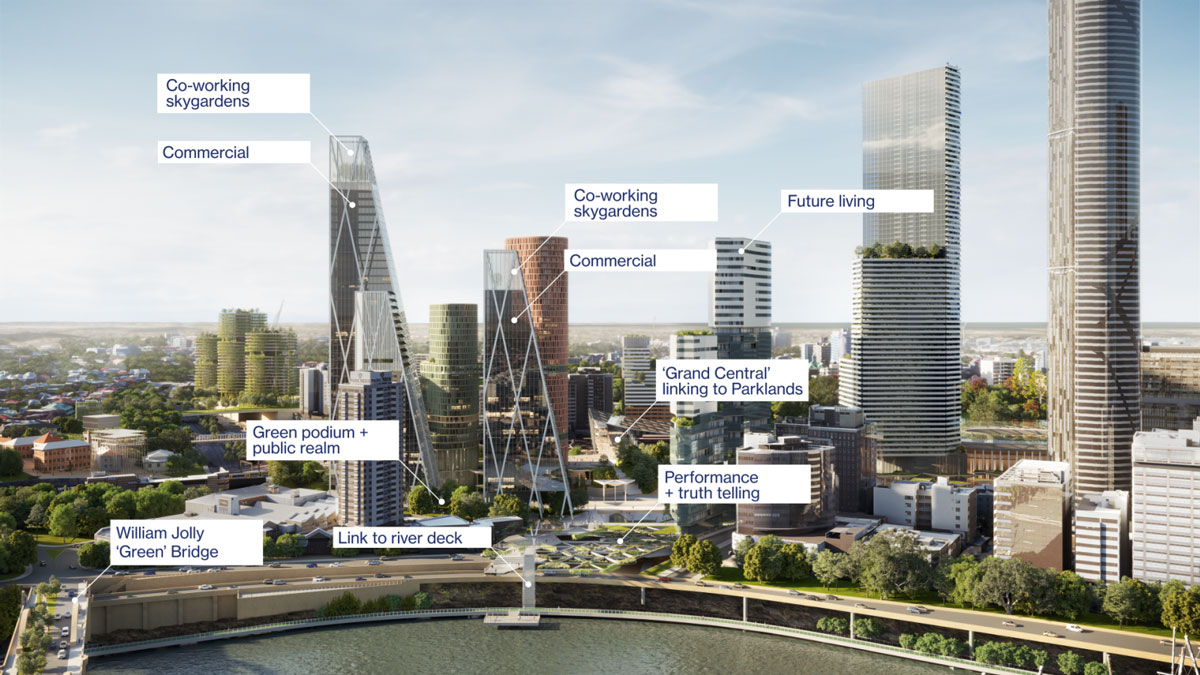
At a glance
- Over 100,000 m2 of new green space (parks, green roofs, green shade canopy)
- More than 100,000 m2 of coworking/commercial/tech space
- Over 80,000 m2 of education and research space
- 7,400+ m2 of maker and creative industry space
- Around 13,000 m2 of retail and hospitality
- Over 4,500 m2 of exhibition and event space
Themes that shaped the design concepts
River
To heal the city’s relationship with the river, the teams aimed to open up public space linking the Roma Street Parklands directly to the river deck – the place that also marks the ancient river crossing between Kurilpa (South Brisbane) and Wilwinpa (parklands area).
Cool Brisbane
The teams looked at new typologies for the tropical city – buildings raised on piloti (columns or pillars), green facades, street-level shade structures and sky gardens, embedding regenerative elements into a highly urbanised environment.
Heritage
By adapting and re-using the Victoria Barracks for tech and creative industries we are preserving the vestiges of a troubled colonial past, the legacy of which is still felt today. At the same time, we are reinventing the space for a contemporary culture by reasserting the living traditions of our First Nations peoples.
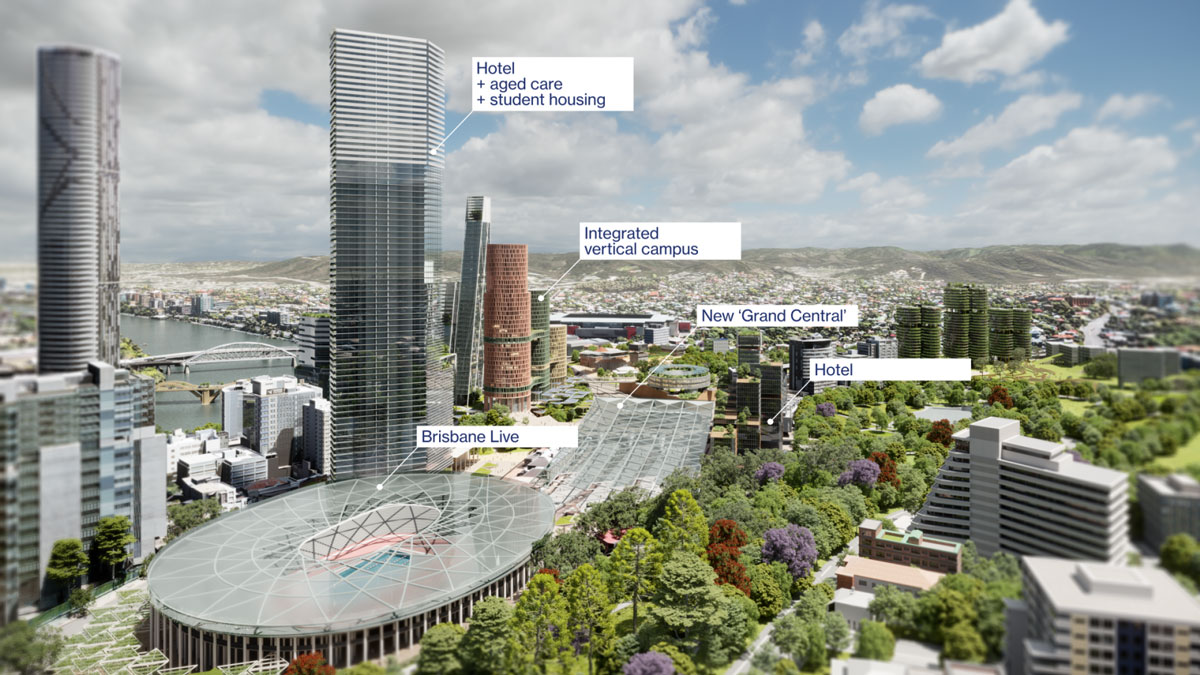
Transport
Sustainable transport is the way cities flourish – connecting people and places via mass transit and active transport like walking and cycling. Reinvigorating the historic Roma Street Station as a new ‘Grand Central’ ensures this critical interchange can evolve with the city.
The new economy
Spaces for start-ups, anchored by a new vertical university campus, fab labs, maker spaces and creative industries, contribute to an ecosystem of innovation. Different environments to suit the differing needs of tech value chain are provided across the precinct.
Solutions for specific sites
Roma Street Station
The river is linked through the public plaza from Roma Street to the heart of the station, with the above-ground lines connected under an uplifting canopy – a new ‘Grand Central’ that forms a direct, active link for pedestrians to reach the parklands. Three linked, vertical campuses for university and post-secondary education and training line Roma Street, along with a hotel and accommodation for students, seniors and key workers.
Roma Street parklands
Along the western fringe, the landscape is terraced, with a green-roofed gallery and knowledge-sharing spaces nestled into the slope. These are crowned with future commercial, tech and mixed-use spaces to form a welcoming, low-rise street edge along College Road. A string of green-wall towers completes the arc of residential and mixed-use buildings already established along the rail lines.
Police headquarters
On this site, an open public plaza spills off Roma Street, just opposite ‘Grand Central’. This space extends above the expressway as a green platform for performance and truth-telling – flanked by residential and commercial buildings – and ends in a viewing platform high above the river. This elevated space connects down to the bikeway and a river deck acknowledging the ancient river crossing.
Victoria Barracks
An elevated landscape bridge connects the parklands, once cut off from Petrie Terrace by the rail yards, to Hardgrave Park and the revitalised Victoria Barracks. The Barracks are opened up to the public as a creative industry, tech and cultural precinct. This preserves all stages of the Barracks’ heritage, with a mix of new co-working, ‘fab labs’, and maker and arts spaces. This creative community is then linked back to Roma Street and the new ‘Grand Central’ via bridges to the Tech Hub building and oasis park, offering respite amid elevated views to the Western ranges.
As yet, the Queensland Government has not outlined concrete plans for the broader Roma Street Station site which would include the new Brisbane Live entertainment arena.
Architectus are an Australian architecture and design studio specialising in commercial, education, interiors, public, residential, transport, urban design and planning.


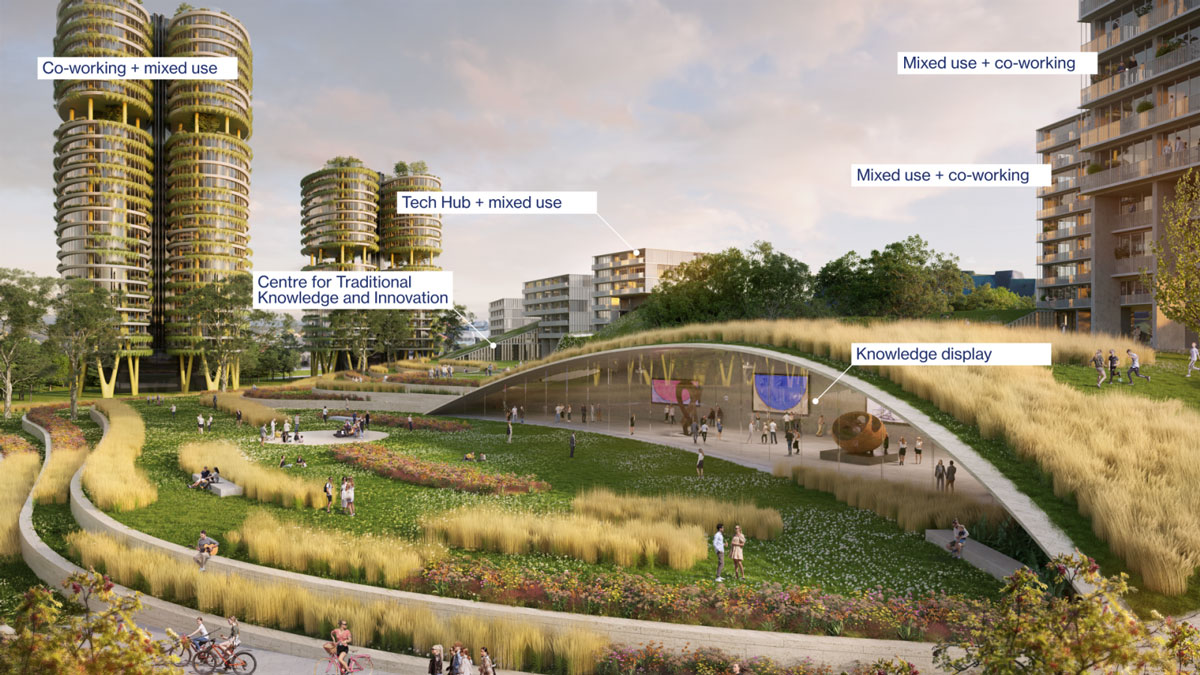

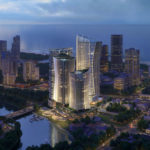
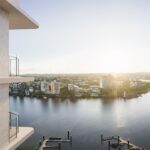
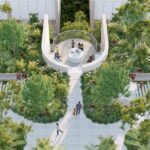
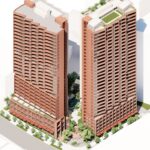


I would love to see this development come true but the chances seem slim. A lot of these developments get lost and never are turned to reality which is so sad when you see projects like this.
What a wonderful dream. Now the commitment and funds are necessary to make it happen!
Regarding the design, greening spaces in the city will help it stay cool as the planet heats. More trees create more shade. In this city, in this climate, there cannot be too many trees. This comes first, then the cultural needs of the people. Without cool outdoor spaces, people will remain indoors in the air conditioned spaces. There should be no compromise on this, no matter what the developer comes up with during building.
Wasn’t part of the scope of works for the public-private development of Brisbane Live a requirement to expand Roma St Parklands. I.e. give back more usable space to the public in exchange for more private buildings (such as the residential towers and vertical Uni) and a stadium?
The original concepts had the entirety of the train lines (separating the parklands from Countess St) covered; to form a huge green space and genuine extension to the parklands. This video just has two landbridges instead.
Sure, the proposed expansion of green space to the river (by demolishing and reclaiming the Police Headquarters and Magistrate’s court) is nice, but that shouldn’t be a substitute.
Here’s hoping Qld Gov’ts plans to develop the site (when they finally get announced) aren’t compromised.
Slightly concerned by all the woke activist lingo. This seems like quite a self indulgent affair, the colonisation of public space by a very small segment of society, possibly fraudulent misuse of funds given how much is off this space revolves around the woke tribe. Not representative of the wider population of Brisbane, stop trying to be a second tier London or NY with this copy and paste modernist w*nkery.
Please leave Roma Street PARKLANDS ALONE. The community has already handed over public land for developers so that high rise could be built on this public land. No more concrete and built structures on open space parkland. LEAVE IT ALONE. This is public land for public enjoyment. Let the city breathe. We live in a subtropical climate. We need as many heat sinks in our city as we can get. We need to be cooling the city not heating it up with the built environment. This is yet another pathetic attempt to take away from open space which attracts our wildlife and make further hotspots in our city. Climate change is real and we need to be doing as much as possible to stem the tide not create more harm.
Great vision!!!
Brisbane desperately needs stronger pedestrian linkages from Petrie Terrace, Suncorp Stadium and the Barracks to the Gardens and Roma Street Station precinct. Also with linkages to Victoria Park in the north. The railway lines and Countess Street have divided the city for too long.
This is a wonderful opportunity to reunite the city, heal a damaged landscape and move Brisbane forward as an international city.
1. Swap the location of Hardgrave Park with the road carriageway of Petrie Terrace so that the houses have parkland directly infront of them instead of a noisy road. This will allow people to enjoy pedestrian access from the suburbs and Suncorp Stadium directly across the land bridges into Roma Street Gardens. Otherwise the pedestrian access across Countess Street will only be resolved. The roadway of Petrie Terrace is also a busy, noisy road and dissects the green space from the people.
2.Completely cover over the roads (Countess St and Petrie Terrace) and railway with parklands as previously proposed as they are traffic sewers and very noisy. If not possible, widen the green bridges and link one of the bridges to the Brisbane Arts Centre and resolve the noise issue with other solutions.
3. Improve pedestrian links from the Barracks and Roma Street Gardens to the Bicentennial Bike/Walkway and William Jolly Bridge through to the Southbank Precinct . The linkages from the Barracks or the Roma Street Gardens through E.E. McCormick Place and then to South Bank are visually unclear and dangerous for pedestrians.The pedestrian links between Brisbane Live and South Bank should be visually legible and safe for pedestrians. It is an unsafe area to walk at night.
4. The public spaces be visually linked to create a legible city not one that relies on signage.
5. Improve the pedestrian link to Caxton St and its entertainment venues from the Barracks complex by resolving the traffic issue along the roadway of Petrie Terrace at the traffic intersection at the Lord Alfred Hotel. It’s a traffic sewer. make it a walkable city.
6. Improve visual connections into the Roma Street Gardens. The city is not very legible for pedestrians. The Gardens entry with the big signboard at the corner of Roma St and Parklands Crescent at Emma Miller Place is very poor as you can’t see the gardens and the footpath narrows and takes you under two bridges. It’s a poor entry to the Gardens with hardscape, vehicles and narrow pathways.
7. Pedestrianise Caxton Street into a plaza with outdoor seating spaces and night lighting from the Barracks through to Suncorp Stadium.
8. Provide a better pedestrian link north-south across Caxton Street between Suncorp Stadium and the heritage significant Ithaca Park as the two parklands are visually cut off from one another and the pathway on the northern side of Caxton Street next to Ithaca Park is too narrow.
9. Improve the vegetation linkages between the north and the river: Link Victoria Park, Roma Street Gardens, Hardgrave Park and then south to EE McCormick Park to improve wildlife corridors to the river foreshore to help restore a damaged landscape and promote water sensitive urban design.